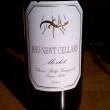Ice Wine Science, Part 1: Volatile issues

By Tom Mansell, Science Editor
I recently had the opportunity to participate in part of the ice wine grape harvest at Sheldrake Point Vineyards, located on the west side of Cayuga Lake. Ice wine grapes can and should be harvested under specific conditions. Sheldrake Point winemaker David Breeden likes to harvest between 12 and 18 degrees Fahrenheit, but it's a delicate balance.
In frozen grapes, some of the water crystallizes into ice, segregating sugars and acids into a more concentrated solution. The degree of "frozen-ness" of the grapes will determine the concentration of the syrupy solution which will be extracted from the frozen grapes in the press.
If the grapes are too warm (closer to 18F), they may start to melt and juice extracted may not be concentrated enough. If the grapes are too cold, the juice may be too concentrated. Getting this right can be difficult and time-sensitive. In spite of careful weather-watching and scheduling, harvest times are basically up in the air until the morning thereof, when phone calls ring out into the breaking dawn and crews either wait a few hours or come in a few hours early. This particular picking was scheduled for Friday, then rescheduled for Saturday at 8 a.m., then moved up to 10 a.m., then back to 8:30 a.m.
Breeden tends to shoot for Brix levels between 35 and 40 (at right is Dave checking the brix of the must on Saturday). That's about 35-40 percent sugars by weight.
At first, this might seem like a feast for yeast. Unfortunately, the concentrated sugary environment is not all that pleasant for them due to what's called osmotic stress. That is, the high dissolved solid content puts enormous pressure on the yeast cell membranes to maintain equilibrium.
Or to put it another way, it's like putting salt on a slug.
This stress leads to slow and difficult fermentations for ice wines. It also allows for some ambient microorganisms besides yeast to join the party.
Acetobacter and wine have been interacting for millenia; they're responsible for the conversion of wine into vinegar. In this case, while the yeast struggle to survive in their syrupy environment, Acetobacter and other spoilage bacteria can move in and set up shop on the surface, using ambient oxygen to turn ethanol into acetic acid (smell: vinegar), which can esterify into ethyl acetate (smell: nail polish). The combination of these two is known as volatile acidity (VA).
It turns out, though, that the biggest producers of VA in high-Brix musts are the yeast themselves. The stress caused by the high-sugar environment causes up-regulation of yeast enzymes that produce acetate. Thus, careful selection of yeast strain and tight control of fermentation conditions are important for making quality ice wine.
At Sheldrake, Breeden manages osmotic stress in his fermentations by employing a method of gradual addition of the sweet must, which maintains a Brix level between 25 and 30 throughout the fermentation. The similarities of this method to a standard semi-batch reactor with substrate inhibition kinetics just sets the chemical engineering part of my heart all aflutter.
Too much volatile acidity can render a wine unpalatable, but like many faults, small amounts of VA can add complexity to a wine. Peach and pineapple aroma characteristics, for example (hexyl acetate, ethyl butanoate) can come from esterification of acetic and other volatile acids, and descriptors like this are very common in ice wine tasting notes.
The presence of some VA, due to osmotic stress on yeast in a high sugar environment, gives the bouquet of ice wine unique characteristics that set it apart from normal table wines.
In the second part of our exploration of the science of ice wine, I'll discuss the palate and mouthfeel of ice wine and other characteristics that add to the honey-like richness that it provides.
Further Reading:
Erasmus et al., "Impact of Yeast Strain on the Production of Acetic Acid, Glycerol, and the Sensory Attributes of Icewine", American Journal of Enology and Viticulture, 2004.














Tom,
Great piece on ice wine. When we started back in 2000 with our first ice wine, based on my Ontario experience we decided to produce only the classic wine and so adopted the essential elements of the VQA (Vintners Quality Alliance) production standards. These standards are for a natural process and are accepted internationally. Grapes frozen on the vine between -8 and -12C (produce sugars between 36 to 40+brix), then pressed immediately (not storred in a freezer.
Regards, Bob
Bob: I was looking for just such a standard for the States (i.e., 10-18F), but the only one I found from TTB is that grapes must be frozen on the vine. Thanks for the info.
It seems like while a lot of Finger Lakes wineries have “iced” offerings (late harvest fruit frozen after picking), there aren’t as many that do the traditional, straight-up ice wine.
Great stuff. Both the coverage, and the icewine .
.
I’m squarely in the camp of those enjoying a slight VA edge when it comes to icewine. Looking forward to the followup piece.
Great article on ice wine. Like NY, Michigan makes some great ice wine. I’d recommend an Ice Gewurtztraminer from Bowers Harbor as something different.
As a producer of traditional Icewine, The “iced” or “Vidal Ice” offerings drive me nuts. While these are nice wines, the flavors aren’t the same as frozen on the vine, and it causes consumer confusion.
Duncan:
Some of those differences will be addressed in the second part of this series. Stay tuned…
Tom, here are my notes from teaching the WSET Diploma. These are the VQA regulations in Canada and have been adopted by the EU for Ice wine production. Some of my comments are interspersed with tht the notes.
Grapes must be picked frozen without artificial refrigeration until the grapes are pressed.
Grapes must be picked at a minimum of -8 degrees centigrade (17 Degrees F) typically -10 to -13 degrees, below –14 can’t extract any juice.
Take 3 kg of Riesling and 3kg of Vidal to make one 375ml bottle of ice wine . You get 6-7 time less juice than normally picked grapes
Colder the temperature the higher the brix
minimum of 35 degrees brix at harvest
Must be pressed within the VA
RS must be 125g/l no enrichment or sweet reserve is permitted - 100g/l in BC
Grapes must be picked frozen without artificial refrigeration until the grapes are pressed.
Repeated freezing and thawing of grapes causes them to dehydrate and concentrates the sugars and acids and intensifies flavor
Hand picked or machine harvested usually at night
Grapes are destemmed and crushed winery doors are left open to maintain the cold
Water in the juice freezes as ice crystals and only little juice remains to be collected.
Juice is clarified, inoculated and a cool fermentation takes place slowly over several months stopping between 10-12% Alcohol with usually 160g/l of residual sugar. No Malo-lactic fermentation but cold stabilization does take place
Blends of grapes are permitted, but not Vidal with vinifera
Hey,
FWIW, we’ve never de-stemmed or crushed icewine grapes before pressing. I can’t imagine how’d you’d move the grapes from the de-stemmer to the press (normally you pump them, but you can’t pump frozen grapes). I suppose if you had a gravity set-up such that your crusher/de-stemmer was over your press, that would work.
I do have to wonder about how all that treatment, even at cold temperatures, would affect the temperature of the grapes.
I’m also not sure about the “6-7 times less juice” than with conventional pressing. We get 140 gal/ton with conventional pressing for whole cluster pressing, and ~80 gal/ton for whole-cluster icewine pressing. We do also lose about 2/3 of the weight (for every 3 tons of grapes we leave in October, we harvest 1 ton in January), so maybe that’s how they get the math? 1/2 of 1/3 is 1/6?
Anyway, thanks again for the article, Tom! It’s great to see all these comments!
Dave
Dave, Thanks for your feedback. I need to make sure I am accurate with what I’m writing. What I wrote was gleened from tasting with Karl Kaiser as well as the entry in the North American Oxford Companion to Wine edited by Bruce Cass. Perhaps I may have gotten the terminology mixed meaning pressed when I wrote crushed. I’ll check my notes that lead to the write up. I’ll retweet this and perhaps get a few more ice wine makers to chime in.
Hey mark,
Thanks for your comments, and the reply. I didn’t mean to be critical-I was mainly curious (especially about how one would move de-stemmed maybe crushed icewine grapes). I’d heard in other places that people do this, and have never been able to figure it out.
Dave, I checked my notes, it came from the mouth of Karl Kaiser at Inniskilin and is also in their tech sheets on ice wine. I don’t know how they do it either. We are a little to warm in SE PA for us to try and if we did it would be vidal.
Mark